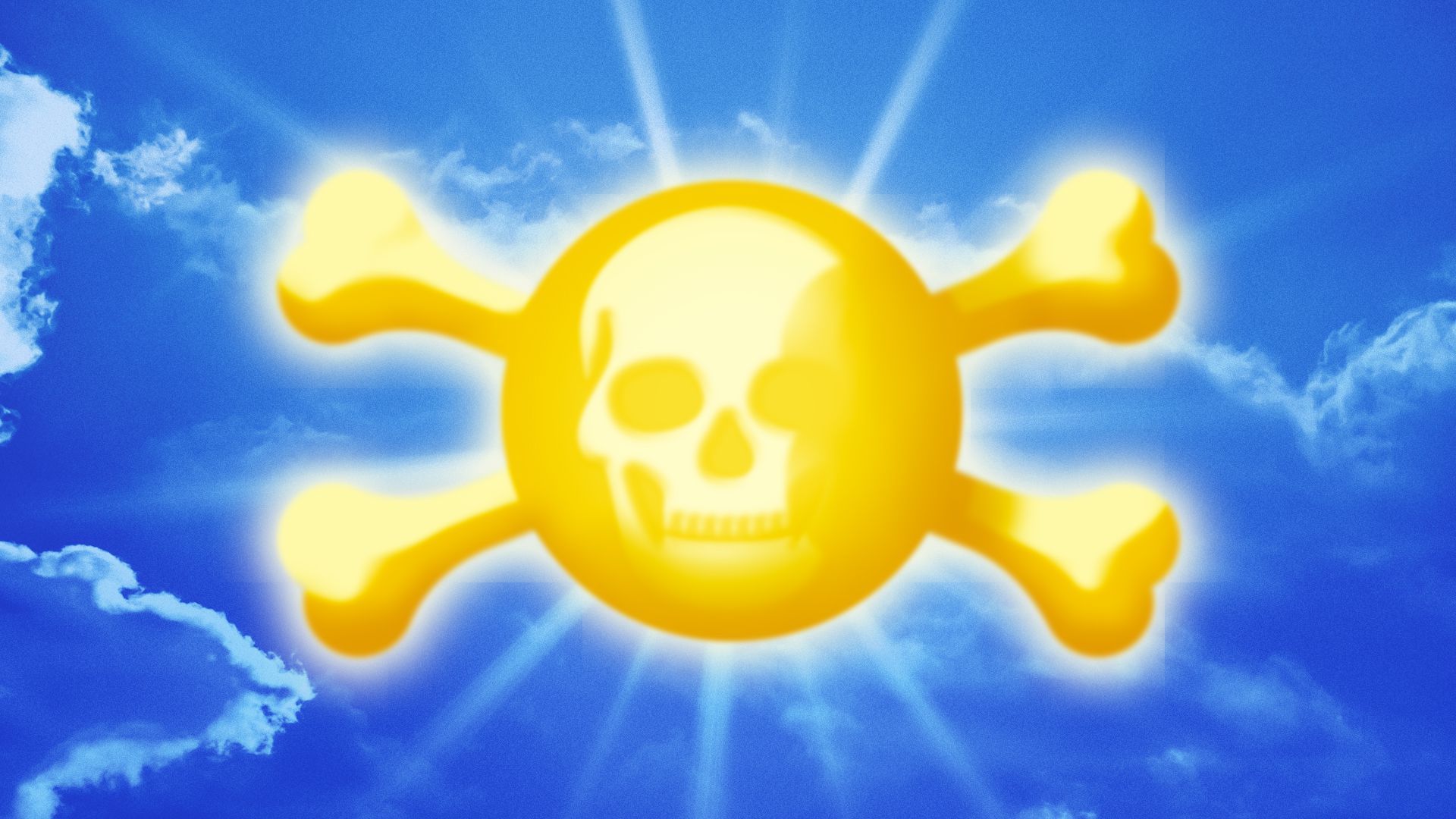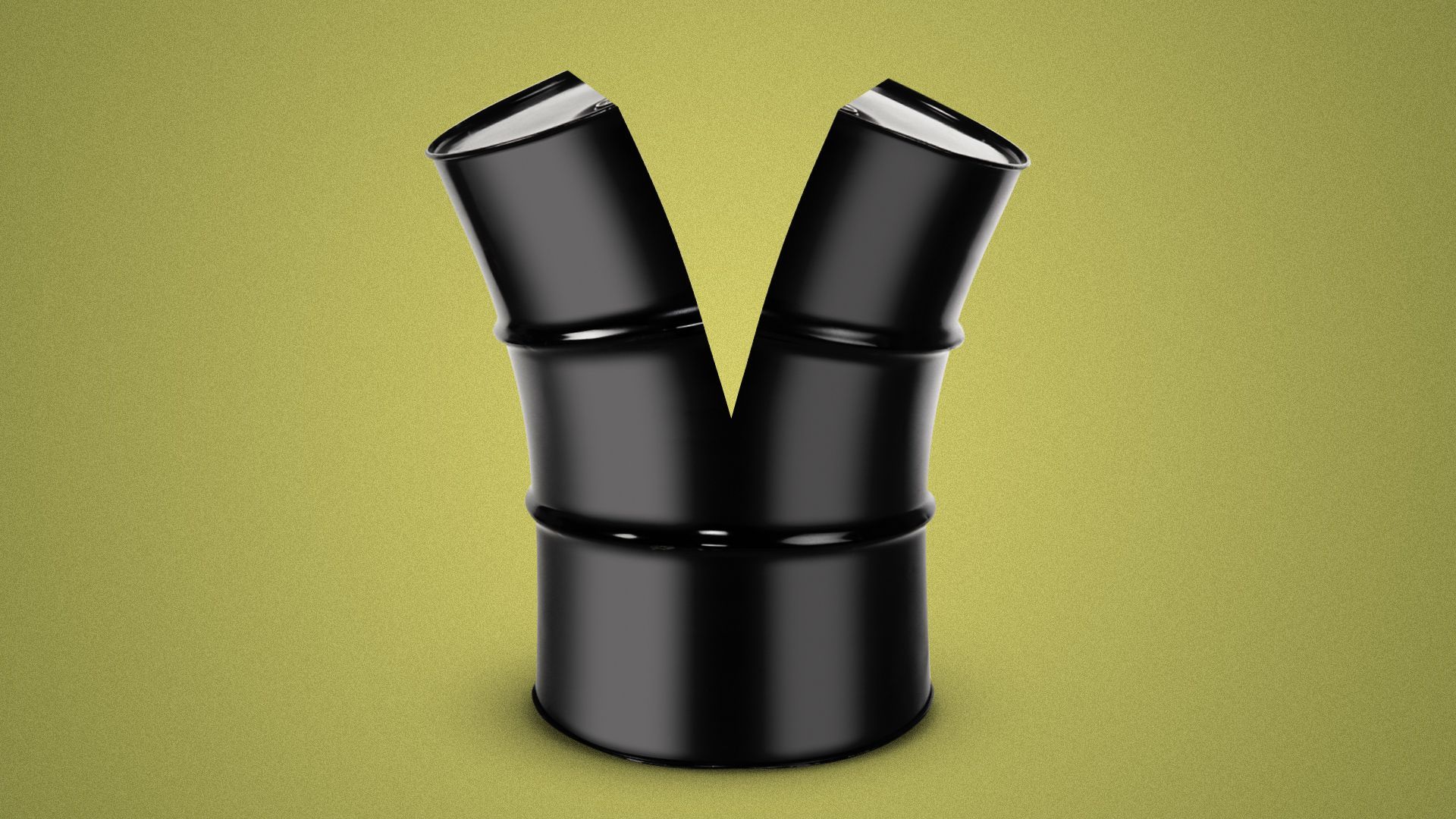| | | | | | | Presented By ICE | | | | Axios Generate | | By Ben Geman and Andrew Freedman · Jun 08, 2022 | | 🐪 Oh yes, it's Wednesday. Today's edition, edited by Mickey Meece, has a Smart Brevity count of 1,176 words, 4.5 minutes. 🗓️ Tomorrow: Join Axios journalists at 12:30pm ET for a virtual event about the effects of misinformation on climate action and public health. Guests include White House climate adviser Gina McCarthy. Register 🎶 On this date in 1999, Pearl Jam released a terrific cover that's today's intro tune... | | | | | | 1 big thing: U.S. faces a potentially disastrous summer |  | | | Illustration: Sarah Grillo/Axios | | | | This U.S. is in store for another summer of extreme heat, hurricanes, droughts and wildfires — threats that are all escalating because of climate change, and experts are advising preparedness, Andrew writes. The big picture: Parts of the Arctic and Alaska are already burning. So are large swaths of New Mexico. After two years of especially devastating summer disasters, experts say the potential for catastrophe is only growing. - Summer used to be synonymous with freedom and fun. Now, the Union of Concerned Scientists, an environmental research and advocacy group, calls it "the danger season."
How it works: The warmer months come with inherent natural variability. When that acts in concert with trends related to climate change, extreme weather events can vault from "rare and uncomfortable" to "unprecedented and deadly." Threat level: The ingredients are there for another destructive summer. "All of the environmental, oceanic, and atmospheric conditions are loudly pointing to elevated risk for the rest of the year," said Steve Bowen, head of catastrophe insight for Aon. - He cautions that warning signs on paper do not always translate into "worst-case event occurrences," but to be prepared just the same.
What they're saying: Climate scientists are preparing for things to get worse — not just in their work, but also personally. - Michael Wehner, a senior scientist at the Lawrence Berkeley National Laboratory, said he has stocked up on HEPA air filters in case wildfires cause the air quality to deteriorate where he lives.
- "Like many Californians, I am bracing for yet another fiery summer given the severe drought currently across the western U.S.," he told Axios.
- "What concerns me, of course, is that many people cannot afford these expensive filters nor get out of harm's way," he said.
Read more. |     | | | | | | 2. ⛅The limits of Biden's solar moves | | A pair of news reports signal headwinds facing new White House efforts to speed solar projects and spur more U.S. manufacturing, Ben writes. Catch up fast: The White House this week announced a two-year waiver of potential new panel import tariffs, coupled with the use of the Defense Production Act to boost domestic panel-making. Yes, but: Bloomberg reports the Biden administration has limited cash to use for DPA-based support for domestic projects — and that it's competing with other DPA uses like baby formula. It reports that the plan currently depends on a fund with less than $500 million. Why it matters: "That funding—even if fully dedicated to solar production—would only be enough to open a few factories capable of cranking out a fraction of the panels the U.S. currently imports each year, according to manufacturers." However, officials plan to seek more money from Congress. And the story also notes that supporters say the DPA can unlock other Energy Department "tools and authorities to invest in manufacturing." Meanwhile, AP reports domestic manufacturers are weighing legal challenges to the waiver of tariffs which may flow from the Commerce Department probe of whether China's dodging import penalties. Go deeper by signing up for Axios Pro Climate Deals. |     | | | | | | 3. Warning flare lit on the race for gas |  | | | Illustration: Annelise Capossela/Axios | | | | The dash for more fossil fuels in the wake of Russia's invasion of Ukraine is poised to squelch the last chance the world has to limit the severity of global warming to 1.5°C, according to a new report out today, Andrew writes. Why it matters: The report, from the nonprofit Climate Action Tracker, amounts to a warning from a respected climate progress watchdog about the potential for emissions lock-in. The big picture: Planned LNG import facilities in the European Union, the report finds, could end up supplying a quarter more gas to Europe than was flowing into the region prior to the conflict. - The report spotlights plans for Middle Eastern nations as well as African countries to tap their gas supplies for European buyers.
- "If all of these plans materialize, they will either end up as massive stranded assets or they'll lock the world into irreversible warming," the report states.
Context: In a separate assessment released on June 3, the same organization found countries have so far failed to come forward with new, more ambitious 2030 climate targets in the wake of the Glasgow Climate Summit, effectively stalling momentum. |     | | | | | | A message from ICE | | Secure streaming data access in all market conditions | | |  | | | | Against a backdrop volatility, an explosion of streaming market data message rates means many firms are challenged to find new ways to efficiently process information. What you need to know: Conflation can play a critical role. Learn why with insights from ICE. | | | | | | 4. Big Oil's strategic divide on display |  | | | Illustration: Aïda Amer/Axios | | | | Two of the world's largest oil companies this week highlighted the diverging energy transition strategies between European and U.S. multinational giants, Ben writes. Driving the news: U.K.-based Shell is jumping with both feet into the U.S. residential power market, starting in Texas. - The company launched the Shell Energy brand Tuesday with a pledge to provide customers clean power via "renewable energy certificates" (basically a way to indirectly finance development). The NYT has more.
- The move into retail power — beyond their existing, limited presence via a 2017 purchase — comes as Shell is also expanding its global renewable generation. That includes moves into the nascent U.S. offshore wind market.
The intrigue: Shell's retail move came the same day Chevron CEO Mike Wirth offered a different strategy for diversifying beyond oil and gas (which remains the majors' dominant businesses). - Wirth, speaking at a Washington, D.C., think tank, emphasized the company's hydrogen and carbon capture projects — and why Chevron's not jumping into the renewables sector that's becoming a big focus for European majors.
- "Wind and solar is great technology. Big fan of it, not a deep competence of ours....There are really good developers out there. We don't add much to the equation," he said at a Center for Strategic and International Studies event.
The bottom line: There's plenty of overlap, with Shell and other European majors also involved in carbon capture and hydrogen. But renewables and power services are a key divide. |     | | | | | | 5. Charted: Europe's U.S. LNG surge |  Reproduced from EIA; Chart: Axios Visuals Europe has become by far the largest destination for U.S. LNG exports, Ben writes. The big picture: 74% of U.S. LNG cargoes went to Europe in the first four months of this year, up from 34% on a full-year basis in 2021, per the Energy Information Administration. Europe already needed more gas during last year's energy crunch and now is looking to wean itself from Russian supplies. What's next: A lot more volume heading to Europe in coming years, if a March agreement with EU leaders is implemented. |     | | | | | | 6. Quote of the day | | "We think it's very important to be looking in areas that I call off-road map. They're too new to show up anywhere." — Jennifer Gerbi, acting head of DOE's Advanced Research Projects Agency-Energy That's part of her E&E News interview about ARPA-E's work to help develop and commercialize new climate tech. |     | | | | | | A message from ICE | | 4 motivations that drive ESG data use | | |  | | | | Data is a key to the ESG revolution, and a more tailored approach can help inform better outcomes. How it's done: It can be helpful to examine the motivation of a data user through four categories: right thing, risk, revenue and regulation. Learn more. | | | | 📬 Did a friend send you this newsletter? Welcome, please sign up. And thanks for reading! We'll see you back here tomorrow. |  | It's called Smart Brevity®. Over 200 orgs use it — in a tool called Axios HQ — to drive productivity with clearer workplace communications. | | | | | | Axios thanks our partners for supporting our newsletters. If you're interested in advertising, learn more here.
Sponsorship has no influence on editorial content. Axios, 3100 Clarendon Blvd, Suite 1300, Arlington VA 22201 | | | You received this email because you signed up for newsletters from Axios.
Change your preferences or unsubscribe here. | | | Was this email forwarded to you?
Sign up now to get Axios in your inbox. | | | | Follow Axios on social media:    | | | | | |









No comments:
Post a Comment